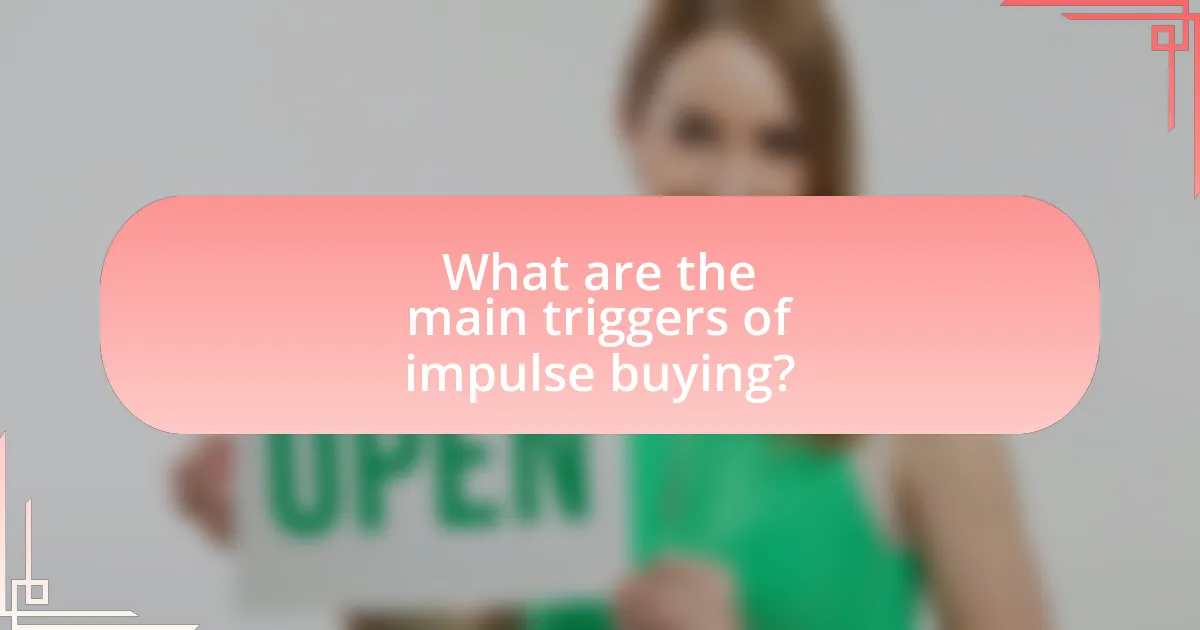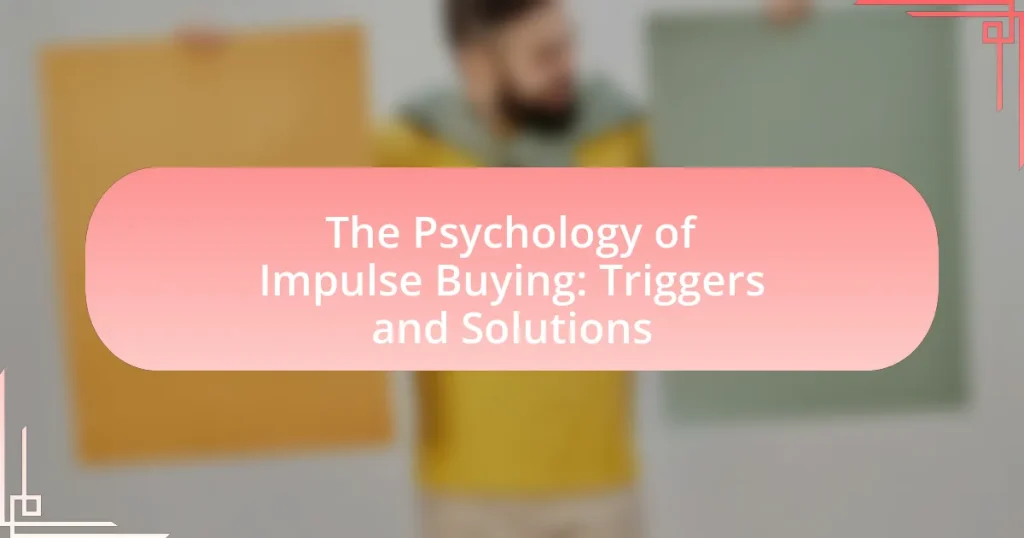The main entity of the article is the psychology of impulse buying, which encompasses the emotional and cognitive processes that lead consumers to make unplanned purchases. The article explores the prevalence of impulse buying, highlighting that 40-80% of consumers engage in this behavior influenced by emotional states, environmental cues, and marketing strategies. It distinguishes impulse buying from planned purchasing, examines psychological factors such as emotional triggers and cognitive biases, and discusses the impact of impulse buying on consumer finances. Additionally, the article provides insights for both consumers and retailers on managing impulse buying through budgeting techniques, shopping strategies, and ethical considerations in retail practices.

What is the Psychology of Impulse Buying?
The psychology of impulse buying refers to the emotional and cognitive processes that lead consumers to make unplanned purchases. This behavior is often triggered by factors such as emotional states, environmental cues, and marketing strategies. Research indicates that approximately 40-80% of consumers engage in impulse buying, highlighting its prevalence in retail settings. Factors like mood, stress, and the presence of sales promotions can significantly influence these spontaneous purchasing decisions. For instance, a study published in the Journal of Consumer Research by Rook and Fisher (1995) found that emotional arousal plays a critical role in impulse buying, suggesting that heightened emotions can lead to less rational decision-making.
How does impulse buying differ from planned purchasing?
Impulse buying occurs when a consumer makes an unplanned purchase, often driven by emotions or immediate gratification, while planned purchasing involves a deliberate decision-making process where consumers research and budget for items before buying. Research indicates that approximately 40-80% of consumers engage in impulse buying, influenced by factors such as store layout, promotions, and emotional states, contrasting with planned purchases that typically follow a structured approach, including a shopping list and pre-determined budget. This distinction highlights the spontaneous nature of impulse buying compared to the calculated strategy of planned purchasing.
What psychological factors contribute to impulse buying behavior?
Psychological factors contributing to impulse buying behavior include emotional triggers, cognitive biases, and social influences. Emotional triggers, such as feelings of happiness or stress, can lead consumers to make unplanned purchases as a way to enhance their mood or alleviate negative emotions. Cognitive biases, like the scarcity effect, can create a sense of urgency, prompting individuals to buy items they perceive as limited in availability. Additionally, social influences, including peer pressure and the desire for social acceptance, can drive impulse purchases as individuals seek to conform to group behaviors or trends. Research indicates that approximately 70% of consumers report making impulse purchases due to emotional states, highlighting the significant role emotions play in this behavior.
How do emotions influence impulse buying decisions?
Emotions significantly influence impulse buying decisions by triggering immediate desires that override rational thinking. Positive emotions, such as happiness or excitement, can lead consumers to make spontaneous purchases as a way to enhance their mood or celebrate a moment. Conversely, negative emotions, like stress or sadness, may drive individuals to engage in retail therapy, seeking comfort through shopping. Research indicates that approximately 70% of impulse purchases are driven by emotional responses rather than necessity, highlighting the strong connection between emotional states and buying behavior.
Why is understanding impulse buying important for consumers and retailers?
Understanding impulse buying is crucial for consumers and retailers because it influences purchasing behavior and sales strategies. For consumers, recognizing the triggers of impulse buying can lead to more informed decision-making, helping them avoid unnecessary expenditures and manage their budgets effectively. Retailers benefit by leveraging insights into impulse buying to optimize product placement, marketing strategies, and promotional offers, ultimately increasing sales. Research indicates that approximately 40% of consumers admit to making impulse purchases, highlighting the significance of this behavior in retail environments.
What impact does impulse buying have on consumer finances?
Impulse buying negatively impacts consumer finances by leading to unplanned expenditures that can strain budgets and increase debt. Research indicates that approximately 60% of consumers engage in impulse buying, often resulting in financial regret and stress. This behavior can deplete savings and contribute to credit card debt, as consumers may purchase items they cannot afford. A study published in the Journal of Consumer Research found that impulse purchases can lead to a 30% increase in monthly spending, highlighting the significant financial consequences of such behavior.
How can retailers leverage impulse buying to increase sales?
Retailers can leverage impulse buying to increase sales by strategically placing high-margin products near checkout areas and utilizing eye-catching displays. Research indicates that approximately 70% of purchasing decisions are made in-store, highlighting the effectiveness of visual merchandising in prompting spontaneous purchases. Additionally, retailers can create a sense of urgency through limited-time offers or exclusive deals, which can trigger impulse buying behavior. For instance, studies show that scarcity and time-limited promotions can significantly enhance consumer urgency, leading to increased sales. By understanding and applying these psychological triggers, retailers can effectively capitalize on impulse buying tendencies to boost their overall revenue.

What are the main triggers of impulse buying?
The main triggers of impulse buying include emotional factors, environmental cues, and promotional strategies. Emotional factors such as stress, excitement, or boredom can lead consumers to make unplanned purchases as a way to enhance their mood. Environmental cues, such as store layout, product placement, and sensory stimuli like music and lighting, can create an atmosphere that encourages spontaneous buying behavior. Additionally, promotional strategies like discounts, limited-time offers, and scarcity tactics can create a sense of urgency, prompting consumers to buy items they did not initially intend to purchase. Research indicates that approximately 70% of purchases in retail settings are made on impulse, highlighting the significant impact of these triggers on consumer behavior.
How do environmental factors influence impulse buying?
Environmental factors significantly influence impulse buying by creating stimuli that trigger emotional responses and decision-making processes. For instance, store layout, lighting, and music can enhance the shopping experience, leading to increased likelihood of unplanned purchases. Research indicates that ambient conditions, such as pleasant scents and engaging displays, can elevate mood and encourage consumers to buy more spontaneously. A study published in the Journal of Retailing found that consumers exposed to ambient scents were 20% more likely to make impulse purchases compared to those in neutral environments. Thus, environmental factors play a crucial role in shaping consumer behavior and driving impulse buying.
What role does store layout play in encouraging impulse purchases?
Store layout significantly influences impulse purchases by strategically guiding customer movement and product visibility. An effective layout, such as the use of open spaces and strategically placed displays, encourages shoppers to explore more areas of the store, increasing the likelihood of unplanned purchases. Research indicates that 70% of purchasing decisions are made in-store, highlighting the importance of layout in capturing consumer attention and facilitating impulse buying. For instance, placing high-margin items near checkout areas can lead to increased sales, as customers are more likely to add these items to their carts while waiting in line.
How do promotional strategies affect impulse buying behavior?
Promotional strategies significantly enhance impulse buying behavior by creating a sense of urgency and perceived value. For instance, limited-time offers and discounts can trigger emotional responses that lead consumers to make unplanned purchases. Research indicates that 70% of consumers report making impulse purchases when exposed to promotional tactics such as flash sales or buy-one-get-one-free deals. These strategies leverage psychological principles like scarcity and social proof, compelling consumers to act quickly to avoid missing out on perceived savings or exclusive opportunities.
What psychological triggers lead to impulse buying?
Psychological triggers that lead to impulse buying include emotional states, social influences, and cognitive biases. Emotional states such as excitement or stress can drive individuals to make unplanned purchases as a form of coping or reward. Social influences, including peer pressure and the desire for social acceptance, can also prompt impulse buying, as individuals may feel compelled to conform to group behaviors. Cognitive biases, such as the scarcity effect, where consumers perceive limited availability as a reason to buy immediately, further contribute to impulsive purchasing decisions. Research indicates that approximately 70% of consumers report making unplanned purchases, highlighting the significant impact of these psychological triggers on consumer behavior.
How do social influences contribute to impulse buying?
Social influences significantly contribute to impulse buying by creating a sense of urgency and social validation among consumers. When individuals observe peers making purchases, they often feel compelled to join in, driven by the desire to conform to social norms or to gain approval from others. Research indicates that 70% of impulse purchases are influenced by social factors, such as friends’ recommendations or social media trends, highlighting the power of collective behavior in shaping consumer decisions. Additionally, environments like shopping malls or social gatherings amplify these influences, as the presence of others can trigger emotional responses that lead to spontaneous buying.
What cognitive biases are associated with impulse buying?
Cognitive biases associated with impulse buying include the scarcity effect, the anchoring effect, and the bandwagon effect. The scarcity effect leads consumers to perceive items as more valuable when they believe they are in limited supply, prompting immediate purchases. The anchoring effect occurs when consumers rely heavily on the first piece of information encountered, such as a high original price, which can make a discounted price seem more appealing and encourage impulsive buying. The bandwagon effect influences individuals to make purchases based on the perceived popularity of an item, as they want to conform to social norms. These biases are supported by research indicating that emotional triggers and cognitive shortcuts significantly impact consumer behavior, leading to unplanned purchases.

What solutions can help manage impulse buying?
To manage impulse buying, individuals can implement strategies such as creating a budget, using a shopping list, and delaying purchases. Establishing a budget helps set clear financial limits, while a shopping list ensures that only necessary items are purchased, reducing the likelihood of unplanned buys. Additionally, delaying purchases for a set period, such as 24 hours, allows time for reflection on the necessity of the item, which can decrease the urge to buy impulsively. Research indicates that these methods can significantly reduce impulse purchases by promoting mindful spending behaviors.
How can consumers develop better spending habits?
Consumers can develop better spending habits by creating and adhering to a budget that tracks income and expenses. Establishing a budget allows consumers to identify discretionary spending and prioritize essential expenses, which can lead to more mindful financial decisions. Research indicates that individuals who maintain a budget are 50% more likely to save money compared to those who do not. Additionally, setting specific savings goals can motivate consumers to limit unnecessary purchases, reinforcing positive spending behaviors over time.
What strategies can individuals use to resist impulse purchases?
Individuals can resist impulse purchases by implementing strategies such as creating a budget, utilizing the 24-hour rule, and avoiding shopping triggers. Establishing a budget helps individuals allocate funds for necessary expenses, reducing the likelihood of unplanned purchases. The 24-hour rule encourages individuals to wait a day before making a purchase, allowing time to evaluate the necessity of the item. Additionally, avoiding shopping triggers, such as specific stores or online platforms that lead to impulsive buying, can significantly decrease the temptation to buy on impulse. Research indicates that these strategies effectively reduce impulsive buying behavior by promoting mindful spending and self-control.
How can budgeting techniques help control impulse buying?
Budgeting techniques can help control impulse buying by establishing clear financial limits and promoting mindful spending. By creating a budget, individuals allocate specific amounts for necessities and discretionary spending, which reduces the likelihood of making unplanned purchases. Research indicates that consumers who adhere to a budget are less prone to impulse buying, as they have a structured approach to their finances that encourages thoughtful decision-making. For instance, a study published in the Journal of Consumer Research found that individuals who track their spending are more aware of their financial situation, leading to decreased impulsivity in purchasing behavior.
What role do retailers play in mitigating impulse buying?
Retailers play a crucial role in mitigating impulse buying by strategically designing store layouts and employing marketing techniques that encourage thoughtful purchasing. For instance, retailers can create clear pathways and organize products in a way that minimizes distractions, allowing customers to focus on their intended purchases. Research indicates that well-structured environments can reduce impulse purchases by up to 30%. Additionally, retailers can implement signage that promotes mindful shopping, such as reminders to stick to a shopping list, which has been shown to decrease unplanned purchases. By utilizing these strategies, retailers effectively influence consumer behavior and reduce the likelihood of impulse buying.
How can retailers create a shopping environment that discourages impulse buying?
Retailers can create a shopping environment that discourages impulse buying by strategically organizing store layouts and product placements. For instance, placing essential items at the back of the store forces customers to navigate past less necessary products, reducing the likelihood of unplanned purchases. Research indicates that consumers are less likely to make impulse buys when they encounter a clutter-free environment, as clutter can overwhelm decision-making processes (Baker et al., 2002, “The Role of the Retail Environment in Consumer Behavior”). Additionally, using clear signage and limiting promotional displays can help maintain focus on intended purchases, further minimizing distractions that lead to impulse buying.
What ethical considerations should retailers keep in mind regarding impulse buying?
Retailers should prioritize transparency and consumer welfare when considering impulse buying. Ethical considerations include ensuring that marketing tactics do not exploit psychological vulnerabilities, such as using misleading promotions or creating artificial scarcity. Research indicates that impulse buying can lead to buyer’s remorse, which suggests that retailers should provide clear return policies and avoid high-pressure sales tactics. Additionally, retailers should consider the long-term relationship with customers by promoting products that genuinely meet their needs rather than solely focusing on short-term sales gains. This approach fosters trust and encourages repeat business, aligning with ethical retail practices.
What practical tips can help consumers avoid impulse buying?
To avoid impulse buying, consumers should implement a strategy of creating and adhering to a shopping list. This approach minimizes unplanned purchases by focusing on specific items needed, thereby reducing the likelihood of being swayed by marketing tactics or emotional triggers. Research indicates that consumers who shop with a list are less likely to make impulse purchases, as they have a clear goal and limit their exposure to unnecessary items. Additionally, setting a budget before shopping can further reinforce discipline, as it establishes financial boundaries that discourage spontaneous spending.


